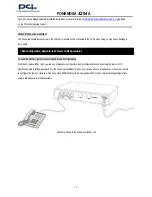
11
3.4 IPSEC Configuration
This sub-page allows configuration of the device's IPSec (IP Security) settings. A sample IPSec
scenario is described below to aid in the configuration description. In this scenario, a SP200X
router establishes a tunnel to other VPN router or another SP200X router. Both the SP200X
router and the remote VPN router are configured to have private LAN subnets (Subnet A
[192.168.1.x] and Subnet B [192.168.2.x] respectively). IPSec in tunneling mode can be used to
establish a secure tunnel between two VPN routers. The SP200X router will send out traffic
through a secure tunnel or normal internet depending on the destination address of the traffic. If a
packet is to be sent through a secure tunnel, the packet will bypass NAT and will be encapsulated
with the router (gateway)'s src/dest address and appropriate encryption and authentication
header/trailers. This way, the packet retains its own subnet information and can be regarded as if
it were originated within a private network (Virtual Private Network).
After the tunnel establishment, a work station in Subnet A should be able to access Subnet B, and
vice versa.
Sample network topology:
Subnet A
IPSec Tunnel
Subnet B
Work Station 1---[SP200X] ================ [VPN router/SP200X] ---- Work Station 2
192.168.1.101 209.85.69.82 209.85.69.116 192.168.2.100
\ /
\ ( ) /
\ ( ) /
( cloud )
( )
( )
























